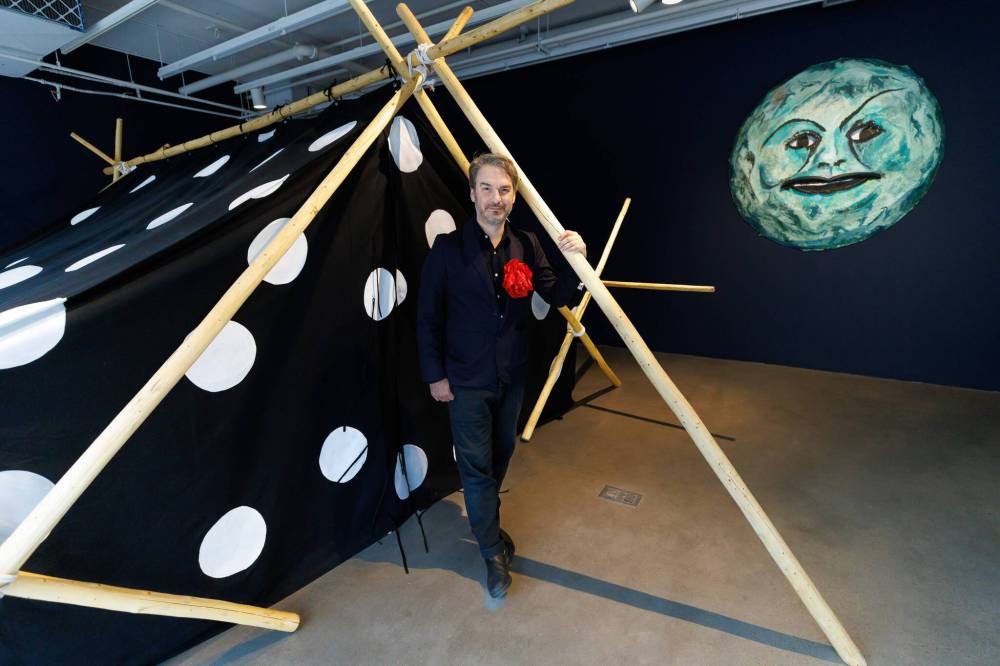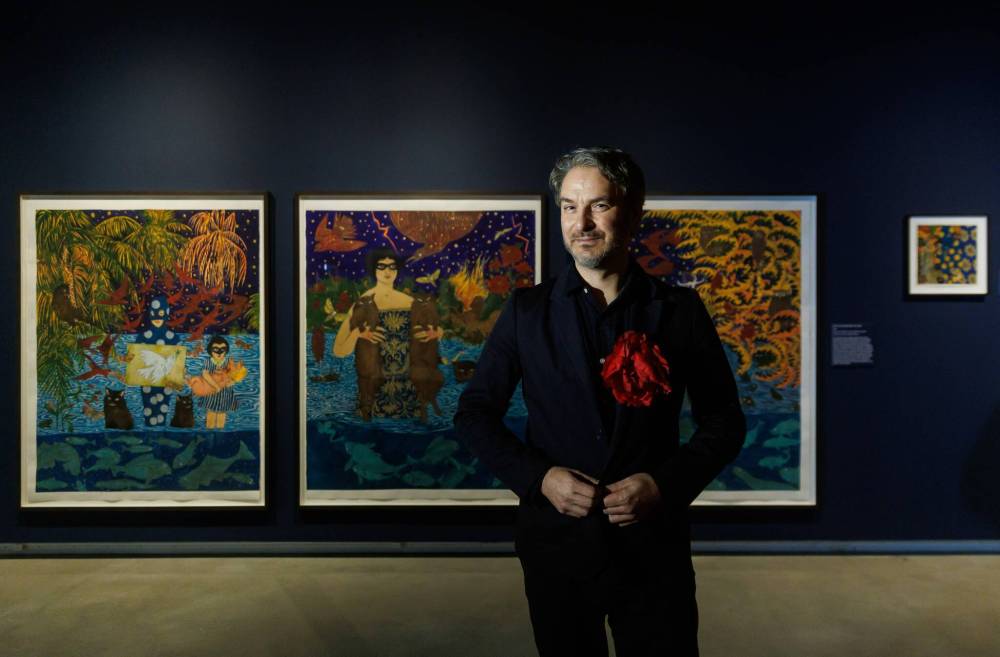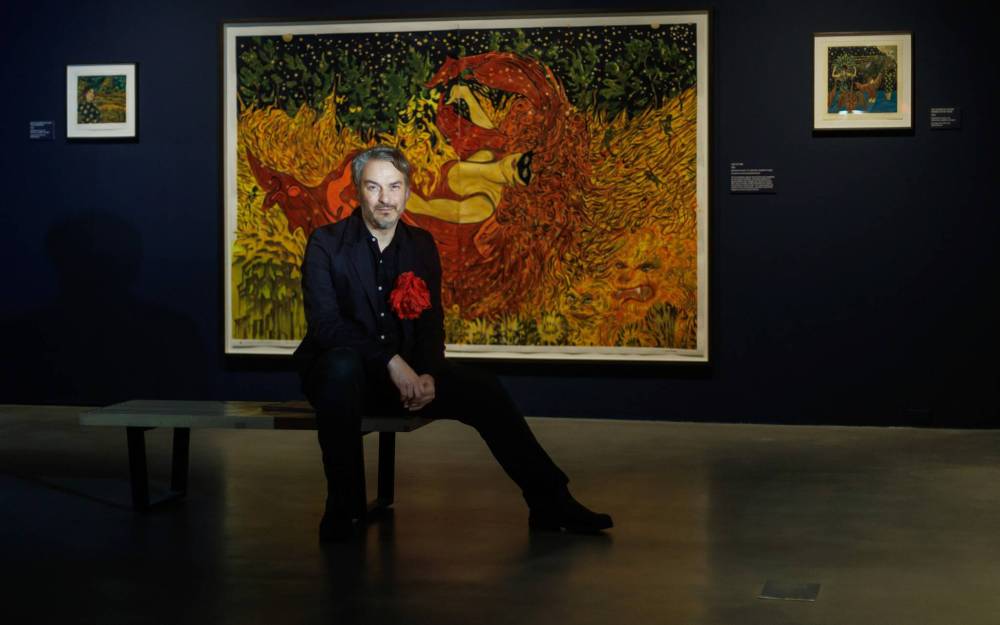Haunting landscapes Prominent Winnipeg-born artist Marcel Dzama channels Group of Seven in rare hometown show
Read this article for free:
or
Already have an account? Log in here »
To continue reading, please subscribe:
Monthly Digital Subscription
$0 for the first 4 weeks*
- Enjoy unlimited reading on winnipegfreepress.com
- Read the E-Edition, our digital replica newspaper
- Access News Break, our award-winning app
- Play interactive puzzles
*No charge for 4 weeks then price increases to the regular rate of $19.00 plus GST every four weeks. Offer available to new and qualified returning subscribers only. Cancel any time.
Monthly Digital Subscription
$4.75/week*
- Enjoy unlimited reading on winnipegfreepress.com
- Read the E-Edition, our digital replica newspaper
- Access News Break, our award-winning app
- Play interactive puzzles
*Billed as $19 plus GST every four weeks. Cancel any time.
To continue reading, please subscribe:
Add Free Press access to your Brandon Sun subscription for only an additional
$1 for the first 4 weeks*
*Your next subscription payment will increase by $1.00 and you will be charged $16.99 plus GST for four weeks. After four weeks, your payment will increase to $23.99 plus GST every four weeks.
Read unlimited articles for free today:
or
Already have an account? Log in here »
Hey there, time traveller!
This article was published 22/11/2024 (368 days ago), so information in it may no longer be current.
Marcel Dzama remembers a day last year when wildfire smoke from Canada had settled thick and heavy over New York City, the place the Winnipeg-born artist has called home for 20 years.
“I was driving my son to school at that time, and there was, like, zero visibility on the Brooklyn Bridge,” he recalls.
It was an evocative, unsettling image, an existential threat made visible on the landscape.
“And it was just like, ‘Oh, what is this terrible thing we’re just leaving for our kids?’”
VISUAL ART PREVIEW
Marcel Dzama: Ghosts of Canoe Lake
Plug In Institute of Contemporary Art, 460 Portage Ave.
To March 8, 2025
Live Chat, Nov. 23 , 2 p.m.
Featuring Dzama, Wayne Baerwaldt, Guy Maddin, Alison Norlen and Robert Enright
Existential threats abound in the surreal Canadiana landscapes that make up Ghosts of Canoe Lake, Dzama’s first major solo exhibition in Canada in a decade.
There are moody skies and inky reflections of jack pines in lakes, but there are also floods and fires and a foreboding sense that all-out catastrophe lurks on the margins.
Dzama, 50, was inspired by the Canadian landscape paintings by the Group of Seven — specifically those by Tom Thomson — as well as his own childhood spent in the harsh Prairie landscapes of Manitoba and Saskatchewan. (A New York Times magazine profile from 2005 has him down as “born in 1974 in the isolated Canadian wilds of Winnipeg…”)
But one can’t paint contemporary landscapes without contending with, well, the contemporary landscape.
The climate anxiety that hums through these works is palpable; the wilderness the Group of Seven immortalized on canvas, carving out a Canadian national identity in the process, has been altered forever.
“It was my fear of what we’re doing to the environment and how we’re just throwing away one of the most important and beautiful things,” Dzama says.
MIKE DEAL / FREE PRESS Wnnipeg-born artist Marcel Dzama is back in his hometown this weekend for the opening of his first Canadian solo show in ten years.
Dzama is in Winnipeg for this weekend’s exhibition opening at the Plug In Institute of Contemporary Art; he’s taking this call on his dad’s landline.
He gets back fairly regularly, but a long absence created by the pandemic had him thinking about the Prairies.
During that same period, Dzama and his own family moved to Long Island and bought a small house in the woods, about a 10-hour drive southeast of where Thomson would have painted scenes from Algonquin Provincial Park, “and I just kind of was taken aback by looking at his work again,” he says.
Thomson’s paintings, coupled with his physical surroundings, made Dzama think about the wild landscapes of his youth — at Birds Hill Park and at his grandparents’ farm.
He thought about the stories his midwife grandmother would tell him about having to walk across the Saskatchewan plains during a snowstorm to help deliver a baby, braving both the elements and the bobcats. (Existential threats have always existed in the Prairies.)
His work Grandmother passing the ecstatic forest in a swarm of star light imagines her as a young woman, guided through a creepy, almost radioactive-looking forest by a shimmering constellation of stars.
And he thought, too, about the vastness of these spaces.
“We’re kind of close to the ocean over there in Long Island and it gives me that exact same feeling as when I go to my grandparents’ farm and just look at the stars in the sky — or you see the aurora borealis — and it’s just so vast and open and you realize how insignificant you are,” he says.
“There’s something humbling about that, though. It feels scary, but there’s some weird comfort in there as well.”
MIKE DEAL / FREE PRESS Dzama’s exhibition, Ghosts of Canoe Lake, was inspired by climate anxiety and the iconic Canadian landscapes painted by the Group of Seven.
Dzama spent a lot of time at his grandparents’ farm.
“I think that’s where I gathered a lot of my strange mythology of animal-creatures,” he says with a laugh, referring to the bats and bears and deer and trees with faces that populate his works, which are held in museum collections all over the world and have appeared on the covers of many albums, those by The Weakerthans and Beck among them.
Thomson, meanwhile, offered a different strange mythology to pull from. The Canoe Lake of the exhibition’s title refers to the lake in Algonquin Provincial Park where a 39-year-old Thomson’s body was discovered eight days after his upturned canoe was found in July 1917.
There has since been more than a century’s worth of speculation about Thomson’s mysterious, untimely death in the very place that so inspired him. It was ruled an accidental drowning, but some people believe he was murdered. Others believe he died by suicide.
Going to art school at the University of Manitoba, the Group of Seven seemed to follow Dzama around.
“There are a few buildings named after the Group of Seven and you hear about them in art history, but at the time, I was almost rebelling against it. I wasn’t very painterly. I kind of had a more comic-book-quality to my work,” he says.
Dzama was following twin obsessions when he began creating the works that would eventually become Ghosts of Canoe Lake.
He had been commissioned to make a film about Spanish poet and playwright Federico Garcia Lorca — another ghost that looms large in the exhibition — but that had fallen through, so he resurrected the idea to create the work To live on the Moon (For Lorca), a film loosely based on Lorca’s 1929 screenplay Trip to the Moon.
“At the same time, I was totally obsessed with Tom Thomson, and was reading all these possible narratives about his death. Lorca ends up getting killed at the end by the fascists before the start of (the Second World War) and so I kind of thought there was this kind of parallel tragedy with Tom Thomson’s mysterious death around (the First World War),” he says.
“(Thomson) objected to the war and he’d get these chicken feathers and stuff from people. And I mean, that could have been one of the reasons he was killed. There’s multiple mysterious reasons why he could have been killed as well — but also, it could have been an accident.”
MIKE DEAL / FREE PRESS Dzama delivers an artist talk Saturday at the Plug In Institute of Contemporary Art for opening of Ghosts of Canoe Lake.
Ghosts of Canoe Lake debuted last December at the McMichael Canadian Art Collection outside Toronto.
Executive director and chief curator Sarah Milroy had talked to Dzama about doing an exhibition focused on his political art; he knew the McMichael was home to one of the largest Tom Thomson and Group of Seven collections in Canada and he wanted to continue to pull that thread.
He ended up making 50 works in a year-and-a-half.
“The obsession was kind of fuelling me, and there was kind of an energetic boost from looking at his work, and then also just looking back at my past in Canada,” he says.
Dzama hadn’t visited here for more than three years owing to the pandemic. When he did finally return, he found himself searching for other ghosts.
“So much had changed since I’d been back to Winnipeg. We’ve lost grandparents and a parent-in-law, and a lot of the places I thought would be around forever were just kind of gone, and so I kind of wanted to pay a little homage to my puppet of the past.”
Ghosts of Canoe Lake is on view until March 8.
jen.zoratti@winnipegfreepress.com

Jen Zoratti is a columnist and feature writer working in the Arts & Life department, as well as the author of the weekly newsletter NEXT. A National Newspaper Award finalist for arts and entertainment writing, Jen is a graduate of the Creative Communications program at RRC Polytech and was a music writer before joining the Free Press in 2013. Read more about Jen.
Every piece of reporting Jen produces is reviewed by an editing team before it is posted online or published in print – part of the Free Press‘s tradition, since 1872, of producing reliable independent journalism. Read more about Free Press’s history and mandate, and learn how our newsroom operates.
Our newsroom depends on a growing audience of readers to power our journalism. If you are not a paid reader, please consider becoming a subscriber.
Our newsroom depends on its audience of readers to power our journalism. Thank you for your support.

